SUBFAMILY MYRMICINAE - Genus Cataulacus
| The Ants of
Africa SUBFAMILY MYRMICINAE - Genus Cataulacus |
|
| Contents - Myrmicinae - MYRMICINAE Introduction |
Genus Cataulacus F. Smith (1853: 225)
In Tribe CATAULACINI.
Diagnostic Features - Head, alitrunk and gaster considerably dorsoventrally compressed and overall appearance of being armoured, and the first gastral tergite forming the whole of the gaster in dorsal view. The full adult colour is mostly uniform black or black-brown, with the antennae, tibiae and tarsi lighter, yellow or yellow-brown. Eyes usually well developed and set behind the mid-length of the head. Antennae 11-segmented with a 3-segmented club. Antennal scrobes below the eyes. Sides of head between the eye and occipital corner often have numerous laterally projecting denticles and the occipital corner usually has a tooth. The dorsum of alitrunk with sutures no more than weakly impressed or absent. The sides of the pronotum are usually marginate with a number of small teeth or an angular projection. Propodeum usually bispinose or bidentate.
Smith's (1853) genus description is at ![]() .
Arnold (1917: 386) gave notes on the genus description; this is at
.
Arnold (1917: 386) gave notes on the genus description; this is at ![]() .
Arnold (1920a: 403) gave a key to South African species, this is at
.
Arnold (1920a: 403) gave a key to South African species, this is at ![]() .
.
Extensively revised by Bolton (1974a), with some later
additions (Snelling, 1979a; Bolton, 1982). The second review by Bolton
(1982) had a fresh key, due to the recognition of species collected
since 1973, a review of some of his previous synonymization, and the
description of six new species. Unfortunately Bolton did not provide
full descriptions of the revived species - jeanneli
and lujae which were revived from synonymy with brevisetosus;
and traegaordhi revived from synonymy with pygmaeus.
Bolton's revised species description (1974a) is at ![]() ;
with his further note (1982) at
;
with his further note (1982) at ![]() .
.
In Bolton's first paper, there were Nigerian records for only six species, one of which, Cataulacus huberi André, was not represented in the CRIN collection. The 1982 revision removed Cataulacus difficilis from the Nigerian list. I collected all but huberi (known from Ile-Ife in Nigeria) and found a further five species - two of which were known from countries both east and west of Nigeria, one was known from the neighbouring Republic of Benin (formerly Dahomey) and two turned out to be new species. From the information given by Bolton, four other species were likely to be present in Nigeria as they are known from countries both to the east and west. Curiously, although the Bernard (1952) treatise on Mt. Nimba, Guinea, is among Bolton's (1974a) references, he (Bolton) appears not to have included any of the Bernard records, which include pullus from Nigeria. Similarly, Bolton (1980) does not have Guinea under the listed occurrences of either pygmaeus or traegaordhi and so the quite numerous findings of "traegaordhi" from Mt. Nimba cannot be clearly identified or separated (see my species notes).
All known members of the genus are arboreal, living and nesting on trees; most are characterised by heavy body armour, presumably for defence and enabling them to co-exist with other aggressive species of ant. Some are known to be involved in the phenomenon of myrmecophily, where the host plants provide cavities for the nests to inhabit.
Most species of the genus have a relatively large range of sizes of what are otherwise monomorphic workers. The size ranges given below are taken from Bolton (1974a, 1982) but the specimens drawn all came within the appropriate size range. In the key, as in Bolton's later review (1982) the term appressed is used rather than adpressed (e.g. adpressus, used by Bolton, 1974a).
Species-groups according to Bolton (1982) -
huberi-group - egenus, huberi,
inermis, kohli, lobatus,
oberthueri, porcatus, pullus,
regularis, tardus,
theobromiclus and wasmanni;
tenuis-group - adpressus, boltoni,
brevisetosus, centrurus, difficilis,
elongatus, impressus, jeanneli,
kenyensis, lujae, moloch,
pilosus, satrap, striativentris,
tenuis, vorticus and weissi;
intrudens-group - bequaerti, ebrardi,
fricatidorsus, intrudens, mckeyi,
micans, mocquerysi, pygmaeus,
traegaordhi, voeltzkowi and wissmanni;
guineensis-group - erinaceus, greggi
and guineensis.
1982 new spp not grouped - cestus, jacksoni
and taylori.
Key to workers of African species (derived from Bolton, 1982):
| 1 | 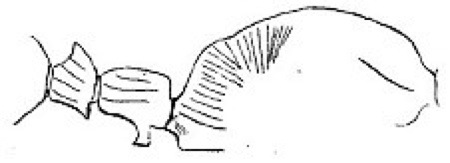 Propodeum
completely unarmed; propodeal dorsum
transversely rugose; TL 6.1 mm Propodeum
completely unarmed; propodeal dorsum
transversely rugose; TL 6.1 mm |
. |
| . | 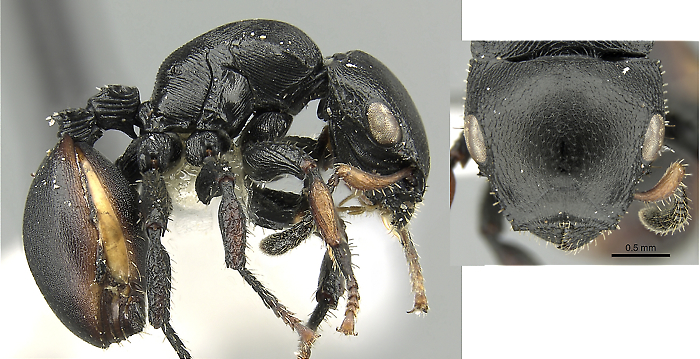 |
Zaïre - inermis |
| -- | Propodeum armed, usually with a pair of distinct spines, if these reduced to teeth then propodeal dorsum not tranversely rugose | 2 |
| 2 | Dorsal alitrunk without standing hairs of any description or at most only 1-2 very short hairs. Generally hairs absent from alitrunk | 3 |
| -- | Dorsal alitrunk with numerous standing and usually conspicuous hairs | 10 |
| 3 | 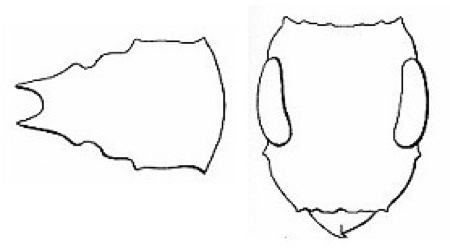 Dorsal alitrunk
strongly
sulcate throughout. Appressed hairs on dorsal alitrunk; TL 3.5 mm Dorsal alitrunk
strongly
sulcate throughout. Appressed hairs on dorsal alitrunk; TL 3.5 mm |
. |
| . | 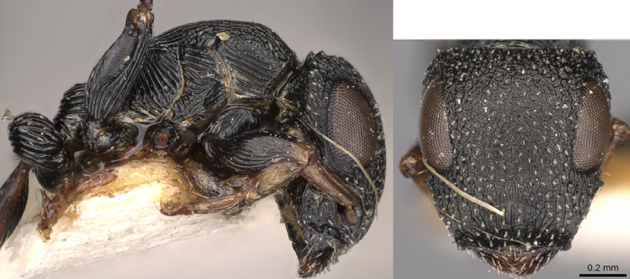 |
Ghana - adpressus |
| -- | Dorsal alitrunk reticulate-punctate to reticulate, usually with fine rugulae but never sulcate; adpressed hairs absent from dorsal alitrunk | 4 |
| 4 | 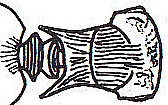 Petiole
dorsally strongly transversely rugose or
sulcate everywhere Petiole
dorsally strongly transversely rugose or
sulcate everywhere |
5 |
| -- | Petiole dorsally variously otherwise sculptured | 7 |
| 5 | 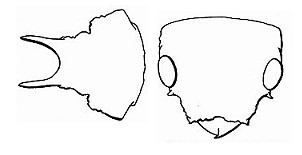 First gastral sternite
laterobasally without a longitudinal margination or carina which
parallels the laterobasal margination of the first tergite; femora of
hindlegs antero-posteriorly compressed; TL 5.1-7.1 mm First gastral sternite
laterobasally without a longitudinal margination or carina which
parallels the laterobasal margination of the first tergite; femora of
hindlegs antero-posteriorly compressed; TL 5.1-7.1 mm |
. |
| . | 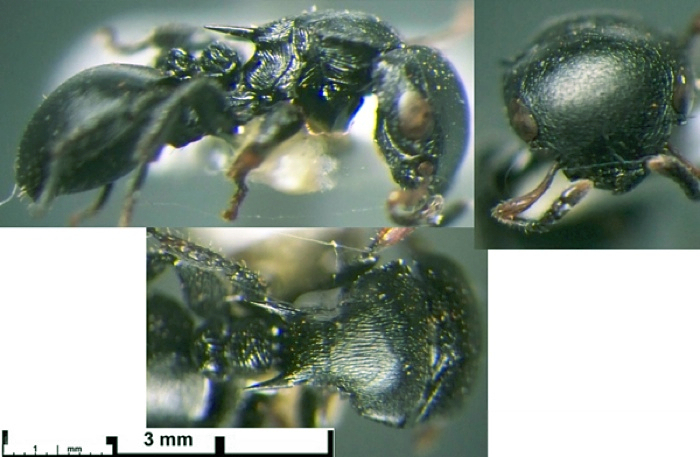 |
West Africa, Congo Basin & Uganda - kohli |
| -- | 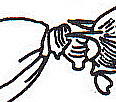 First
gastral sternite laterobasally with a
longitudinal margination or carina which parallels the laterobasal
margination of the first tergite; hind femora not flattened First
gastral sternite laterobasally with a
longitudinal margination or carina which parallels the laterobasal
margination of the first tergite; hind femora not flattened |
6 |
| 6 | 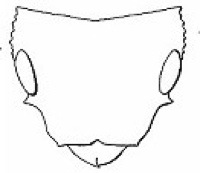 Sides
of head behind eyes irregular,
denticulate, crenulate or otherwise jagged; relatively broad head
widening behind the eyes; laterally projecting hairs on side of head
behind eyes long and conspicuous; TL 5.5-7.8 mm Sides
of head behind eyes irregular,
denticulate, crenulate or otherwise jagged; relatively broad head
widening behind the eyes; laterally projecting hairs on side of head
behind eyes long and conspicuous; TL 5.5-7.8 mm |
, |
| .. | 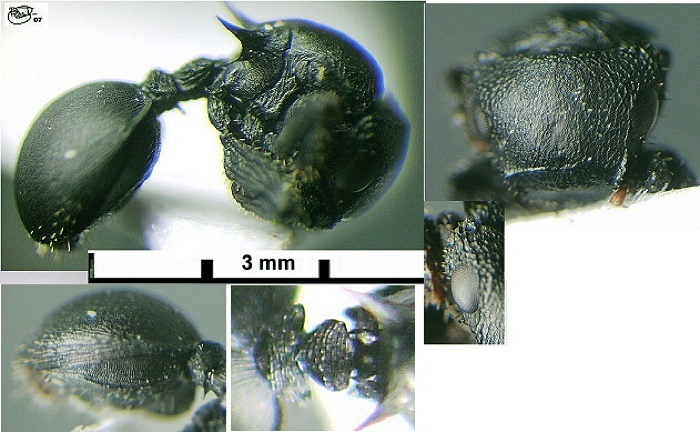 |
West Africa, Congo Basin & Tanzania - huberi |
| -- | 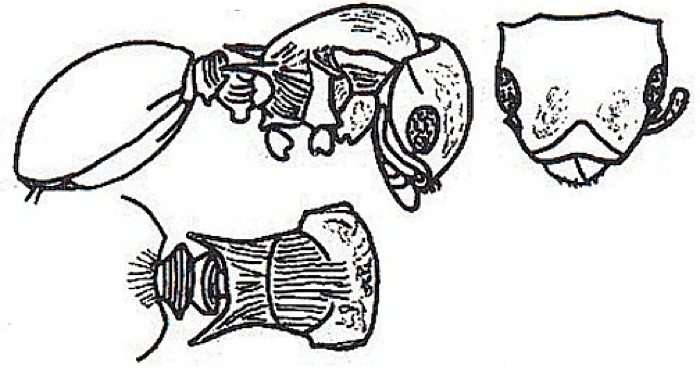 Sides
of head behind the eyes regular and
smooth; relatively narrow-headed, without notable widening; laterally
projecting hairs minute or absent; TL 4.2-6.1 mm Sides
of head behind the eyes regular and
smooth; relatively narrow-headed, without notable widening; laterally
projecting hairs minute or absent; TL 4.2-6.1 mm |
. |
| . | 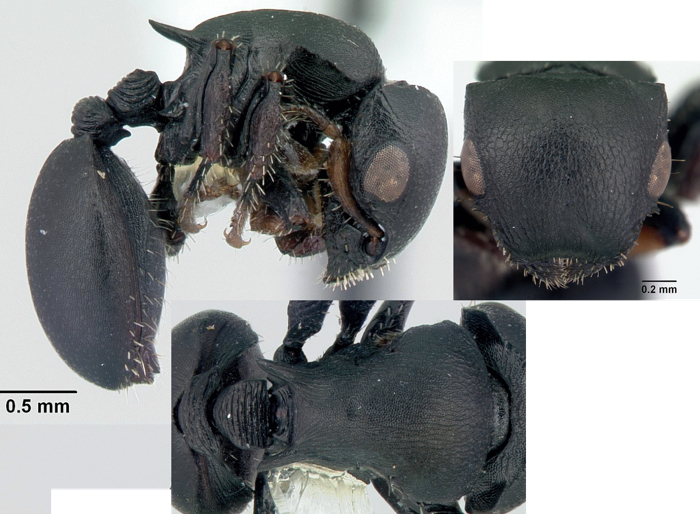 |
West Africa, Congo Basin & Kenya/Uganda - egenus |
| Petiole dorsally not strongly transversely rugose or sulcate | . | |
| 7 | 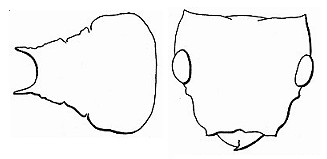 Petiole and postpetiole in
dorsal view very strongly longitudinally sulcate. Postpetiole dorsally
divided into two projecting lobes by a deep median longitudinal cleft;
TL 6.1 mm Petiole and postpetiole in
dorsal view very strongly longitudinally sulcate. Postpetiole dorsally
divided into two projecting lobes by a deep median longitudinal cleft;
TL 6.1 mm |
. |
| . | 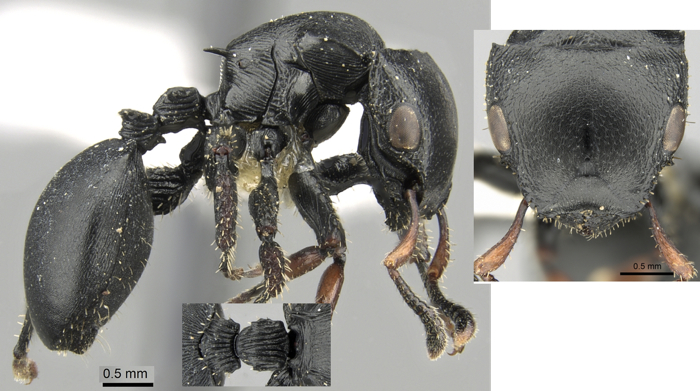 |
West Africa & Congo Basin - lobatus |
| -- | Petiole and postpetiole not strongly longitudinally sulcate, postpetiole not divided | 8 |
| 8 | 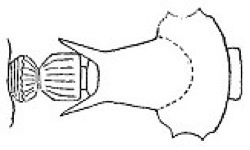 Lateral
pronotal margination with 2 teeth.
Dorsal and lateral surfaces of petiole and postpetiole with numerous
tubercles and small angular prominences; TL 5.3-7.0 mm Lateral
pronotal margination with 2 teeth.
Dorsal and lateral surfaces of petiole and postpetiole with numerous
tubercles and small angular prominences; TL 5.3-7.0 mm |
. |
| . | 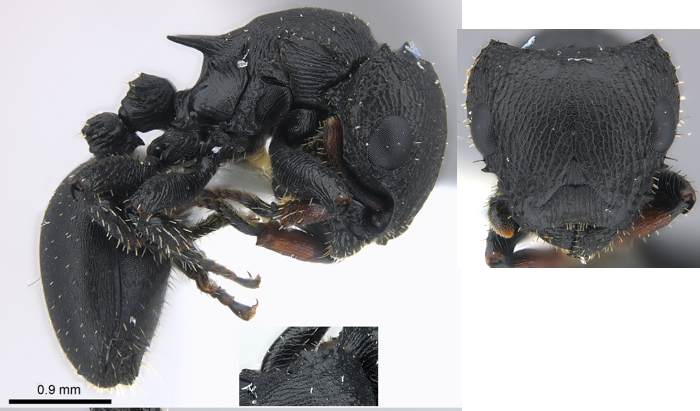 |
West Africa & Congo Basin, also Kenya - pullus |
| -- | 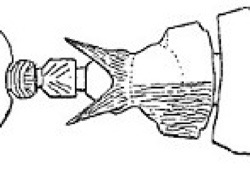 Lateral
pronotal margination with 0-1 teeth.
Dorsal surfaces of petiole and postpetiole without tubercles or small
angula prominences Lateral
pronotal margination with 0-1 teeth.
Dorsal surfaces of petiole and postpetiole without tubercles or small
angula prominences |
9 |
| 9 | 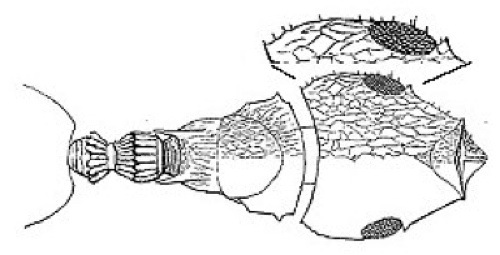 In
full-face view head with
lateral margins behind the eyes with a row of short projecting hairs;
lateral anterior margin of pronotum with a single tooth; TL 6.5 mm In
full-face view head with
lateral margins behind the eyes with a row of short projecting hairs;
lateral anterior margin of pronotum with a single tooth; TL 6.5 mm |
Zaïre - theobromicola |
| -- | 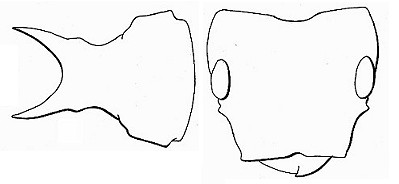 No hairs on margins behind
the eyes; TL 5.4-6.8 mm No hairs on margins behind
the eyes; TL 5.4-6.8 mm |
. |
| . | 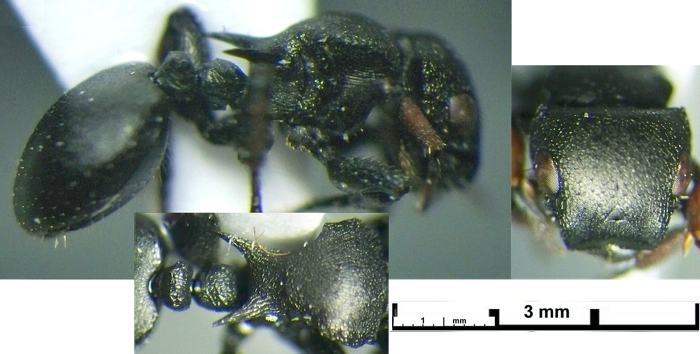 |
West Africa & Congo Basin - tardus |
| Dorsal alitrunk with numerous standing and usually conspicuous hairs | -- | |
| 10 | 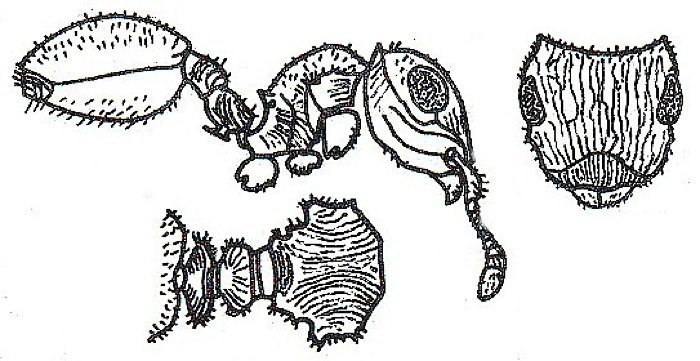 Petiole
and postpetiole strongly transverse,
flattened dorsoventrally and without nodes; both very broadly and
thickly V-shaped in dorsal view. Propodeum with no more than small
teeth or tubercles; TL 4.0-5.5 mm Petiole
and postpetiole strongly transverse,
flattened dorsoventrally and without nodes; both very broadly and
thickly V-shaped in dorsal view. Propodeum with no more than small
teeth or tubercles; TL 4.0-5.5 mm |
. |
| . | 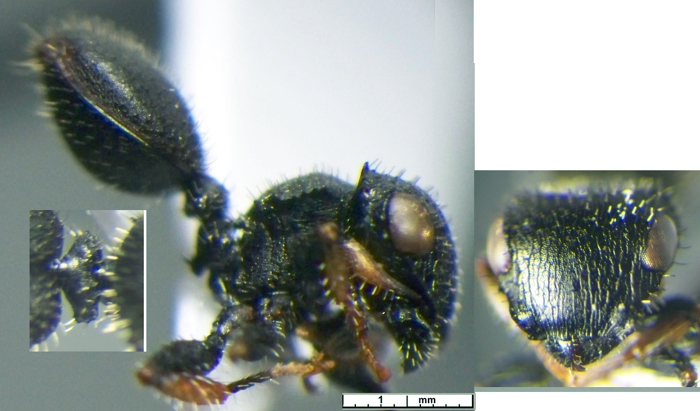 |
West Africa & Congo Basin - mocquerysi |
| -- | Petiole and postpetiole otherwise; well developed propodeal spines | 11 |
| 11 | Hairs on clypeus and usually also on rest of head dorsum bizarre, strongly clavate or stalked-suborbicular; in most the apex of each hair is very strongly swollen, while the stem is narrow | 12 |
| -- | Hairs on clypeus and head dorsum simple, usually stout cylindrical and blunt | 20 |
| 12 | In dorsal view, pronotal margin without an unbroken series of denticles | 13 |
| -- | In dorsal view, pronotal margin with a laterally projecting and unbroken series of denticles | 15 |
| 13 | 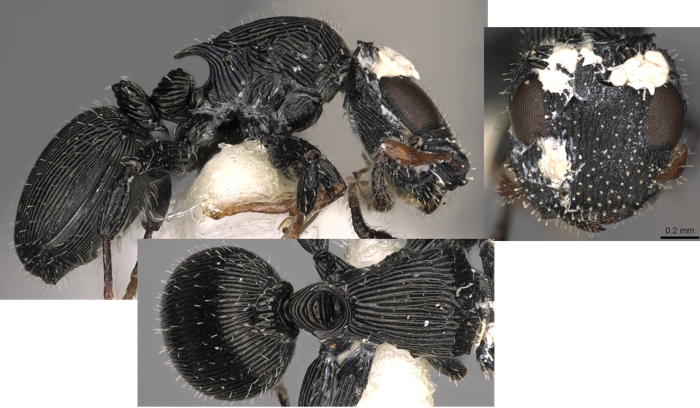 First
gastral tergite regularly longitudinally sulcate throughout; TL 3.5 mm First
gastral tergite regularly longitudinally sulcate throughout; TL 3.5 mm |
Cameroun - jacksoni |
| -- | First gastral tergite reticulate-punctate or with no more than fine rugulae | 14 |
| 14 | 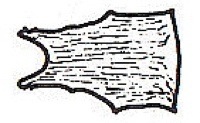 Propodeal
dorsum longitudinally rugulose; TL
3.4-3.5 mm Propodeal
dorsum longitudinally rugulose; TL
3.4-3.5 mm |
. |
| .. | 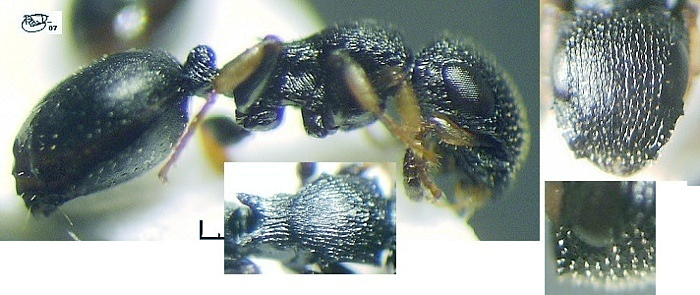 |
West Africa & Congo Basin - vorticus |
| -- | 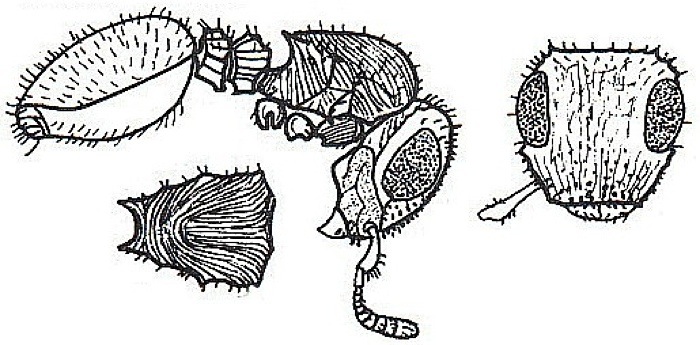 Propodeal
dorsum transversely rugose; TL
2.74-3.08 mm Propodeal
dorsum transversely rugose; TL
2.74-3.08 mm |
. |
| . | 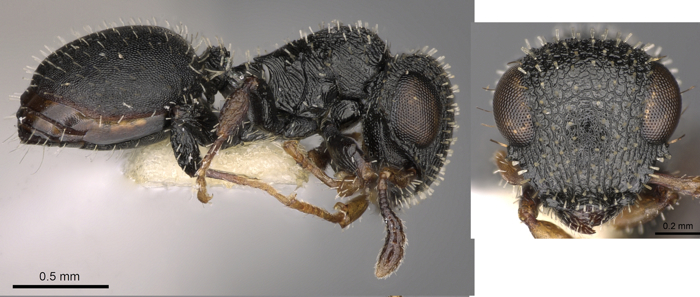 |
Nigeria - boltoni |
 |
In dorsal view, pronotal margin with a laterally projecting and unbroken series of denticles | . |
| 15 | Bizarre hairs on dorsum of head behind the clypeus with a very short basal stem, appearing stud-like, the swollen apices set very close to the cephalic surface; HW < 0.80 | 16 |
| -- | Bizarre hairs on dorsum of head behind the clypeus with an elongate basal stem, never short and stud-like, the swollen apices raised well clear of the cephalic surface | 17 |
| 16 |  HW 0.80 plus; TL 2.5
mm; in full face view eyes with inner
margin weakly incurved HW 0.80 plus; TL 2.5
mm; in full face view eyes with inner
margin weakly incurved |
. |
| . | 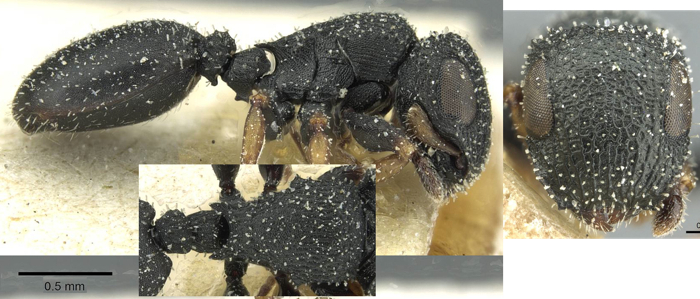 |
Pan-African ? - jeanneli. |
| -- | 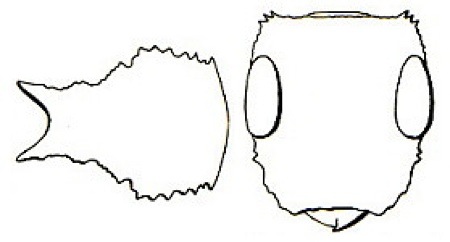 HW < 0.80; TL
2.7-4.0
mm HW < 0.80; TL
2.7-4.0
mm |
. |
| . | 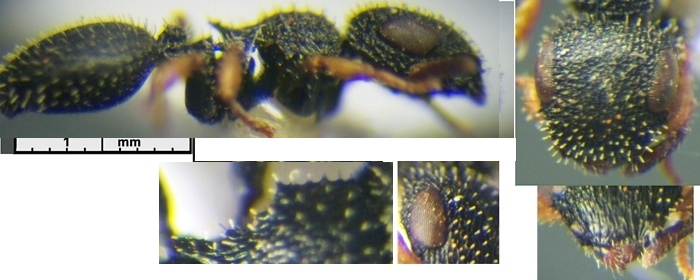 |
southern Africa - brevisetosus |
 17 17 |
Dorsal alitrunk with weak rugulose sculpture and a blanketing dense reticulate-punctate ground-sculpture, which is very conspicuous between the rugulae, the surface matt and dull | 18 |
| -- | 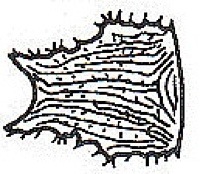 Dorsal
alitrunk with strong dense rugose
sculpture, little or no sculpture between rugae, surface glossy Dorsal
alitrunk with strong dense rugose
sculpture, little or no sculpture between rugae, surface glossy |
19 |
| 18 | 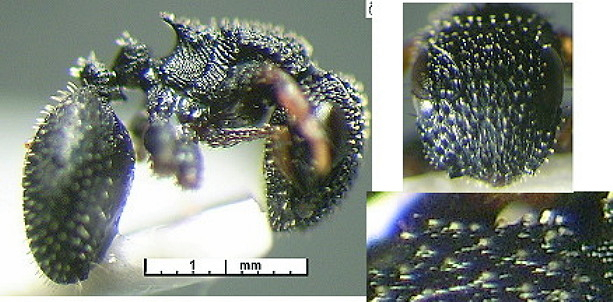 Denticles
on lateral pronotal margins minute and
inconspicuous in dorsal view; dorsum of head with short stud-like
erect hairs; TL 3.4-3.5 mm Denticles
on lateral pronotal margins minute and
inconspicuous in dorsal view; dorsum of head with short stud-like
erect hairs; TL 3.4-3.5 mm |
Cameroun - satrap |
| -- | 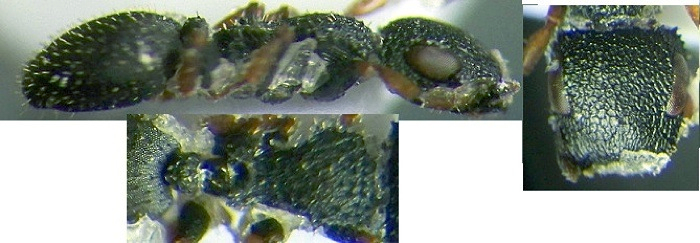 Denticles
large and conspicuous, at least as
large as the tooth at the pronotal corner; TL 3.0-3.2 mm Denticles
large and conspicuous, at least as
large as the tooth at the pronotal corner; TL 3.0-3.2 mm |
West Africa & Congo Basin, also Zimbabwe - lujae |
| 19 | 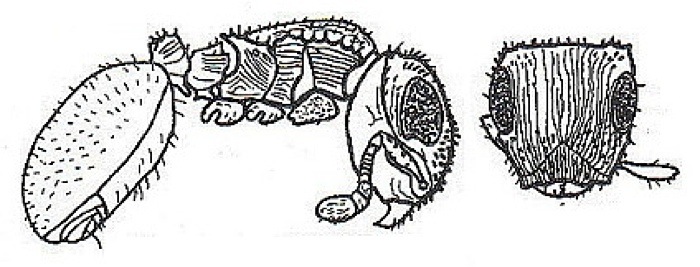 Smaller
species, HW 0.80 or less; body hairs
relatively short; basal quarter of first gastral tergite without strong
rugulae; either punctate or with feeble rugulae due to alignment of
punctures; propodeal spines in profile evenly but feebly curved; TL
2.8-3.2 mm Smaller
species, HW 0.80 or less; body hairs
relatively short; basal quarter of first gastral tergite without strong
rugulae; either punctate or with feeble rugulae due to alignment of
punctures; propodeal spines in profile evenly but feebly curved; TL
2.8-3.2 mm |
. |
| . | 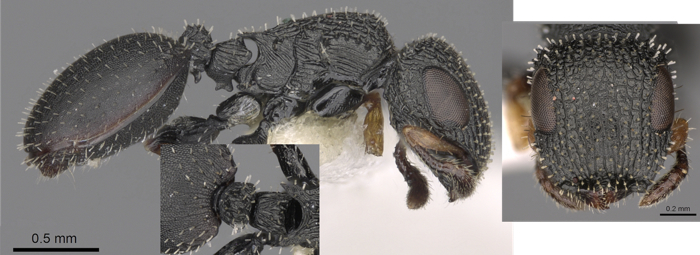 |
Ghana & Nigeria - moloch |
| -- | 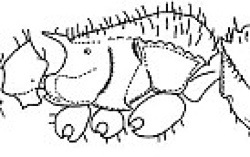 Larger
species, HW > 0.90; body hairs
relatively long; basal quarter of first gastral tergite with strong
longitudinal rugulae, independent of underlying puncturation; propodeal
spines in profile with basal third elevated and apical two-thirds
recurved; TL 3.9 mm Larger
species, HW > 0.90; body hairs
relatively long; basal quarter of first gastral tergite with strong
longitudinal rugulae, independent of underlying puncturation; propodeal
spines in profile with basal third elevated and apical two-thirds
recurved; TL 3.9 mm |
. |
| . | 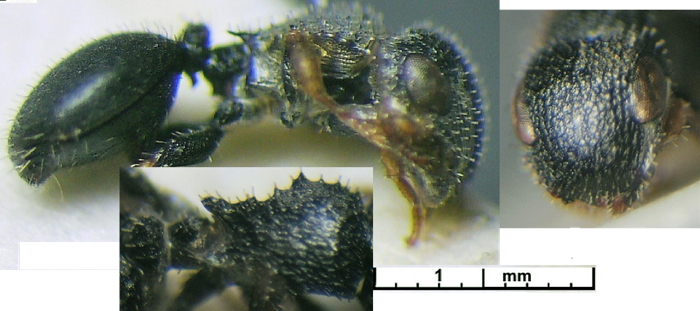 |
Cameroun - centrurus |
| Hairs on clypeus and head dorsum simple, usually stout cylindrical and blunt | -- | |
| 20 | Body covered with abundant, dense, very long, narrow and fine erect hairs | 21 |
| -- | Erect hairs relatively sparse, short, broad and blunt, usually straight, giving ant a bristly appearance | 22 |
| 21 | 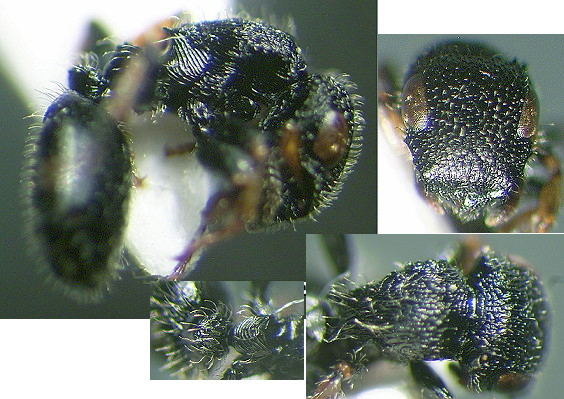 Propodeal
dorsum longitudinally rugose; dorsum
of petiole with arcuate rugae; HL > 0.90, HW > 0.85; TL
3.7-4.4 mm Propodeal
dorsum longitudinally rugose; dorsum
of petiole with arcuate rugae; HL > 0.90, HW > 0.85; TL
3.7-4.4 mm |
Western Coast - Angola north to Ghana - elongatus |
| -- | 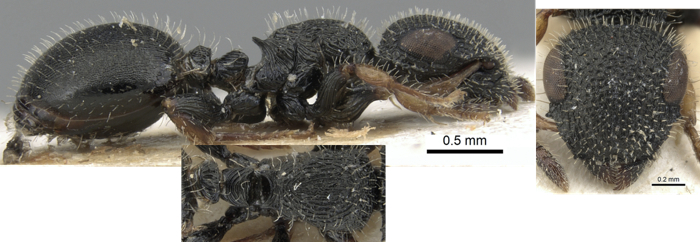 Propodeal dorsum transversely
rugulose, HL < 0.90, HW < 0.85; TL 3.1 mm Propodeal dorsum transversely
rugulose, HL < 0.90, HW < 0.85; TL 3.1 mm |
Zaïre - pilosus |
| 22 | Head relatively broad or very broad, eyes small, CI > 112, OI < 30; in dorsal view postero-lateral portion of pronotal margin produced into a large spine or triangular prominence; propodeal spines long and strong not dorsoventrally flattened | 23 |
| -- | Head relatively narrow and eyes larger, CI 110 or less, OI > 32; no large spine on pronotal margin; propodeal spines usually dorsolaterally flattened | 24 |
| 23 | 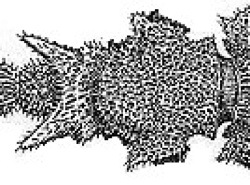 Sculpture
of dorsal alitrunk a very distinct
rugoreticulum with strongly reticulate-punctate interspaces; lateral
margins of mesonotum usually with one or more denticles; TL 8.1-9.5 mm Sculpture
of dorsal alitrunk a very distinct
rugoreticulum with strongly reticulate-punctate interspaces; lateral
margins of mesonotum usually with one or more denticles; TL 8.1-9.5 mm |
. |
| . | 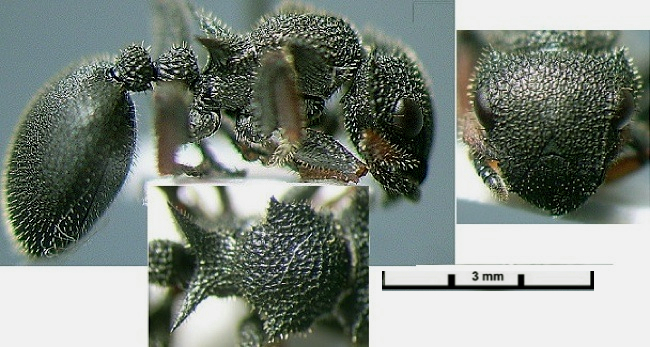 |
West Africa & Congo Basin - erinaceus |
| -- | 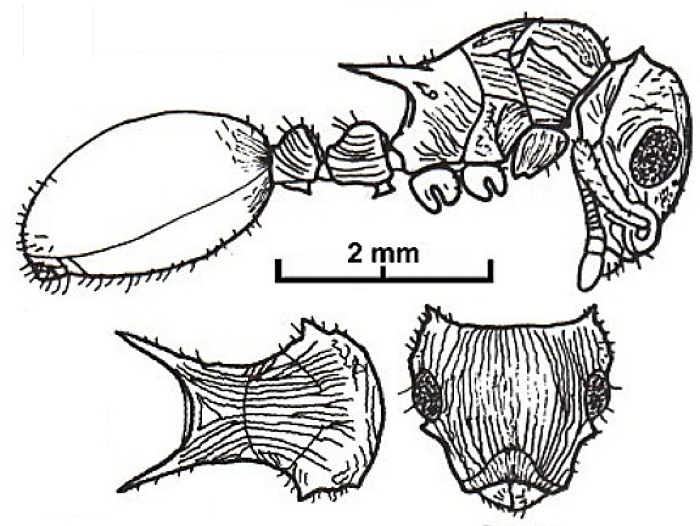 Sculpture
of dorsal alitrunk variable but
essentially longitudinal; lateral margins of mesonotum usually without
denticles; TL 4.5-8.6 mm Sculpture
of dorsal alitrunk variable but
essentially longitudinal; lateral margins of mesonotum usually without
denticles; TL 4.5-8.6 mm |
. |
| .. | 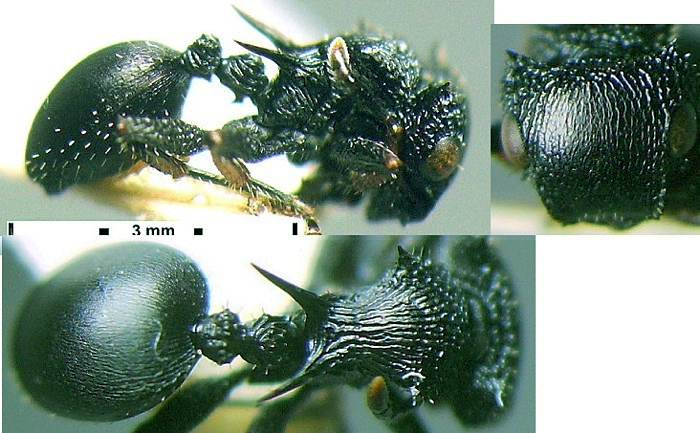 |
West Africa & Congo Basin (also ? South Africa) - guineensis |
 |
Head relatively narrow and eyes larger, CI 110 or less, OI > 32; no large spine on pronotal margin; propodeal spines usually dorsolaterally flattened | -- |
| 24 | At least posterior quarter of first gastral tergite coarsely sculptured | 25 |
| -- | Posterior quarter of first gastral tergite with no more than fine sculpturation | 27 |
| 25 | 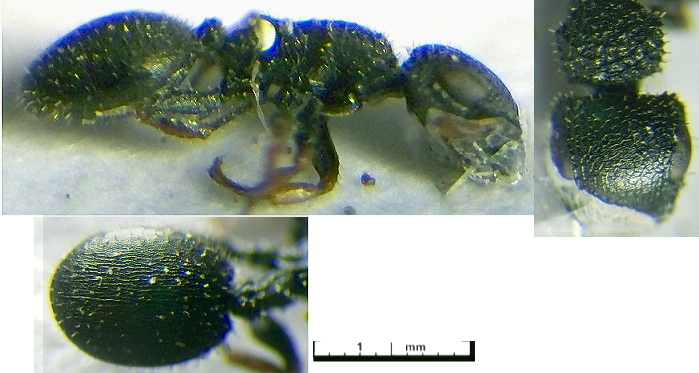 Smaller species, HW
<
0.90 but with relatively large eyes; TL 3.6-3.7 mm Smaller species, HW
<
0.90 but with relatively large eyes; TL 3.6-3.7 mm |
Zaïre & Kenya - striativentris |
| -- | Larger species, HW > 0.90 but with relatively smaller eyes | 26 |
| 26 | 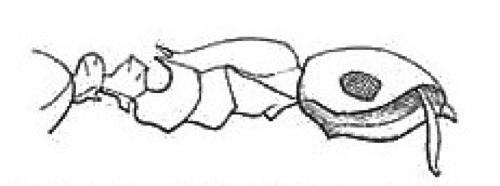 Dorsum of head with
few and
inconspicuous short stubbly hairs; TL 4.3-5.1 mm Dorsum of head with
few and
inconspicuous short stubbly hairs; TL 4.3-5.1 mm |
. |
| . |  |
eastern & southern Africa - intrudens (part, intrudens group) |
| -- | Dorsum of head with numerous long stout hairs | 26A |
| 26A | 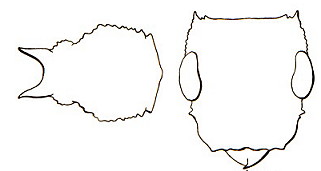 With
eyes relatively small, OI 41-45, head near square CI 98-104 but quite
strongly convex behind the eyes; gaster dorsum with longitudinal rugae
usually broken centrally; subpetiolar process small With
eyes relatively small, OI 41-45, head near square CI 98-104 but quite
strongly convex behind the eyes; gaster dorsum with longitudinal rugae
usually broken centrally; subpetiolar process small |
. |
| .. | 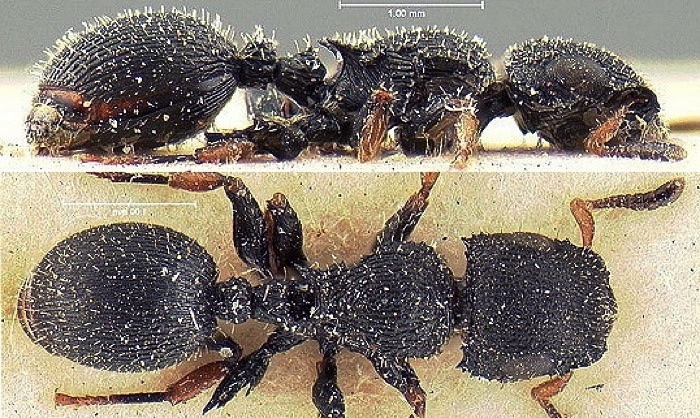 |
eastern & southern Africa - wissmannii |
| -- | 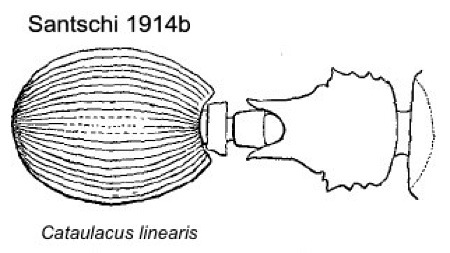 With relatively large eyes
OI =
47, head elongated CI 90; gaster dorsum very strongly linearly rugose,
postpetiole
with quite prominent ventral process With relatively large eyes
OI =
47, head elongated CI 90; gaster dorsum very strongly linearly rugose,
postpetiole
with quite prominent ventral process |
. |
| . | 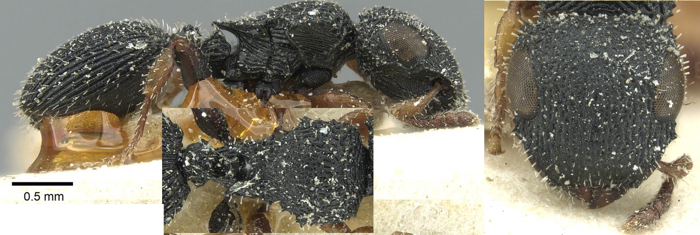 |
eastern & southern Africa - linearis |
 |
Posterior quarter of first gastral tergite with no more than fine sculpturation | . |
| 27 | 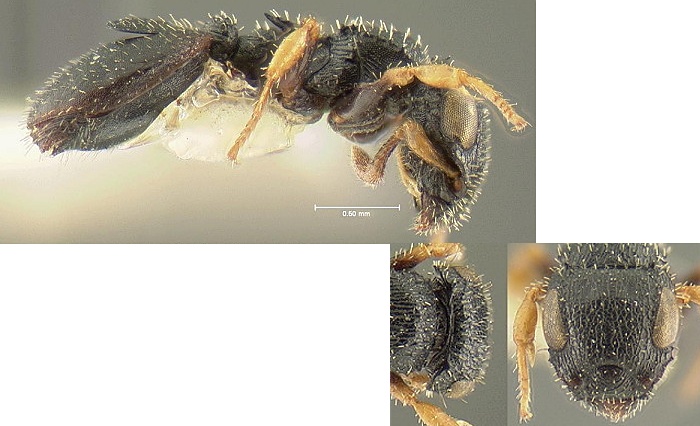 Occiput with a deeply
incised transverse groove but no occipital crest; TL 3.7 mm Occiput with a deeply
incised transverse groove but no occipital crest; TL 3.7 mm |
Uganda - impressus |
| -- | Occiput without a deeply incised transverse groove | 28 |
| 28 | 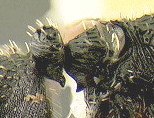 Subpetiolar process
complex,
antero-ventrally with a prominent broadly rounded angle and
posteroventrally with an extended heel or spur, surface between these
usually concave; postpetiole with a strongly developed long digitiform
ventral process Subpetiolar process
complex,
antero-ventrally with a prominent broadly rounded angle and
posteroventrally with an extended heel or spur, surface between these
usually concave; postpetiole with a strongly developed long digitiform
ventral process |
29 |
| -- |  Either the subpetiolar
complex simple, a rectangular or subrectangular lobe unlike above, or
with a feebly prominent acute angle or small tooth posteroventrally, if
the latter the postpetiole with a short blunt or short tooth-like
ventral process Either the subpetiolar
complex simple, a rectangular or subrectangular lobe unlike above, or
with a feebly prominent acute angle or small tooth posteroventrally, if
the latter the postpetiole with a short blunt or short tooth-like
ventral process |
35 |
| 29 | Eyes relatively small, OI < 50 | 30 |
| -- | Smaller species; eyes relatively large, OI 50 or more | 32 |
| 30 | 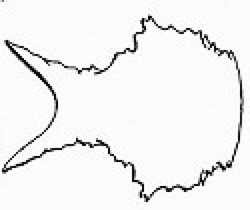 Propodeal
spines long, 0.40 mm or longer in
profile, distinctly longer than petiole, also strongly raised and
divergent; TL 4.6-5.2 mm Propodeal
spines long, 0.40 mm or longer in
profile, distinctly longer than petiole, also strongly raised and
divergent; TL 4.6-5.2 mm |
. |
| . | 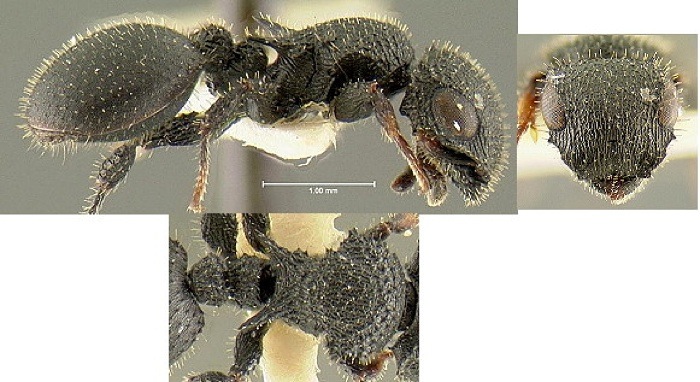 |
West Africa & Congo Basin - greggi |
| -- | Propodeal spines short, < 0.25 mm in profile, distinctly shorter than petiole | 31 |
| 31 | 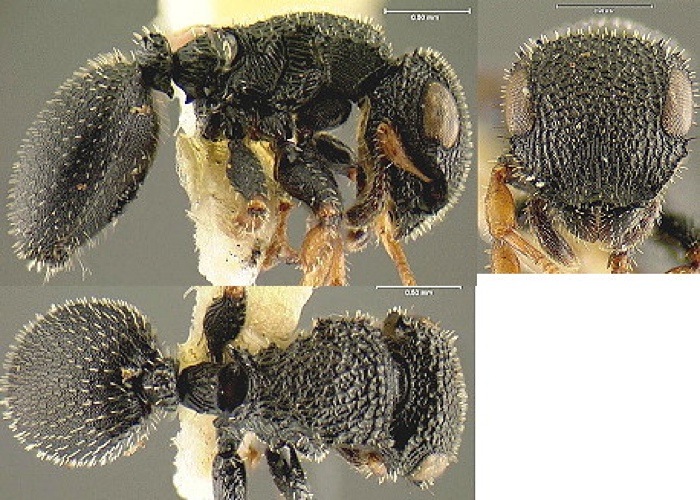 Dorsum
of head with very dense cover of stout
hairs, these mostly cylindrical; TL 4.0 mm Dorsum
of head with very dense cover of stout
hairs, these mostly cylindrical; TL 4.0 mm |
Zaïre - cestus |
| -- |  Dorsum of head with sparse
cover of stout hairs, these conspicuously spatulate; TL 3.6 mm Dorsum of head with sparse
cover of stout hairs, these conspicuously spatulate; TL 3.6 mm |
. |
| .. | 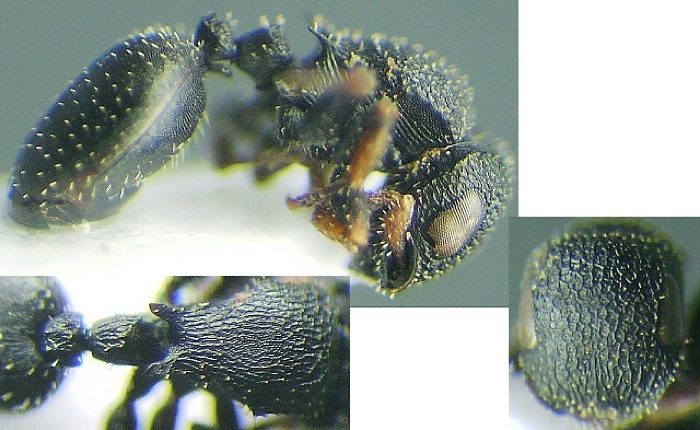 |
Kenya - kenyensis |
 |
Smaller species; eyes relatively large, OI 50 or more | . |
| 32 | 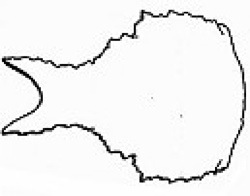 Most
or all of stout hairs on clypeus and dorsum
of head increasing markedly in thickness from base to apex, often apex
2-3 times broader than base; TL 3.7-4.4 mm Most
or all of stout hairs on clypeus and dorsum
of head increasing markedly in thickness from base to apex, often apex
2-3 times broader than base; TL 3.7-4.4 mm |
. |
| . | 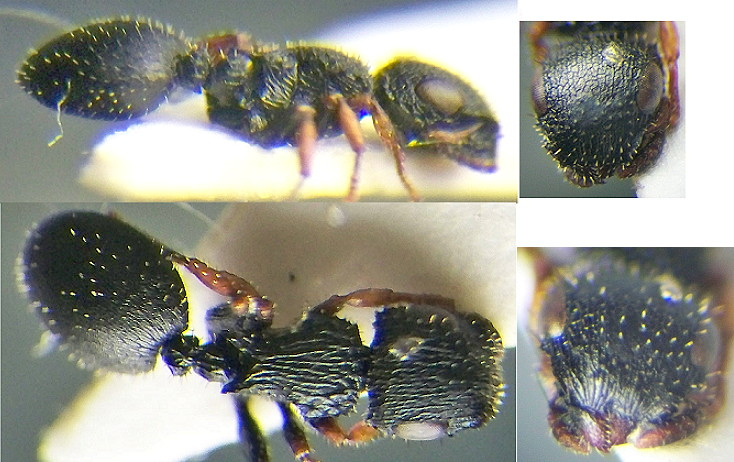 |
West Africa & Congo Basin - pygmaeus |
| -- | Most or all of stout hairs cylindrical or nearly so, not increasing from base to apex | 33 |
| 33 | 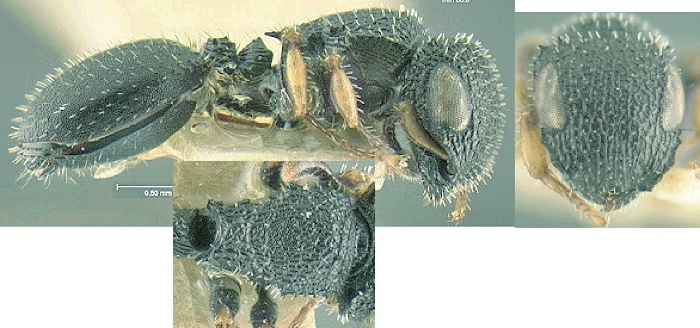 Mesonotal
and propodeal dorsa with very fine
superficial low irregular, weak and wandering rugulae, feeble or faded
out in places but never evenly spaced nor regularly longitudinal;
spaces between fine rugulae densely and strongly reticulate-punctate;
TL 3.3-3.6 mm Mesonotal
and propodeal dorsa with very fine
superficial low irregular, weak and wandering rugulae, feeble or faded
out in places but never evenly spaced nor regularly longitudinal;
spaces between fine rugulae densely and strongly reticulate-punctate;
TL 3.3-3.6 mm |
West Africa & Congo Basin - weissi |
| -- | Mesonotal and propodeal dorsa with conspicuous strong, broad longitudinal rugae; spaces between rugae weakly sculptured or unsculptured, surface shining | 34 |
| 34 | 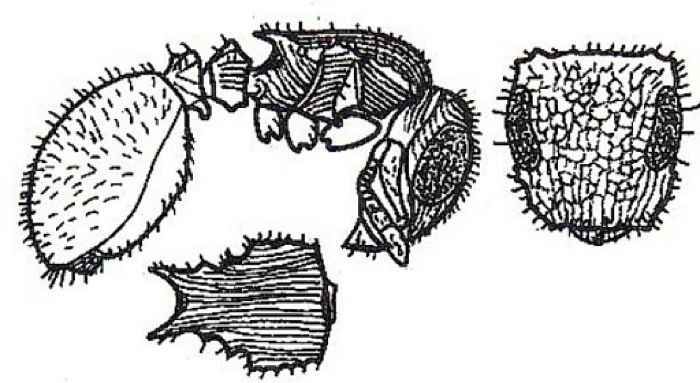 Entire
body exceptionally highly polished and
very shiny; longitudinal rugae on posterior half of mesonotum and
propodeum very broad, subsulcate and parallel, no junctions on
propodeum; TL 3.2-3.5 mm Entire
body exceptionally highly polished and
very shiny; longitudinal rugae on posterior half of mesonotum and
propodeum very broad, subsulcate and parallel, no junctions on
propodeum; TL 3.2-3.5 mm |
. |
| . | 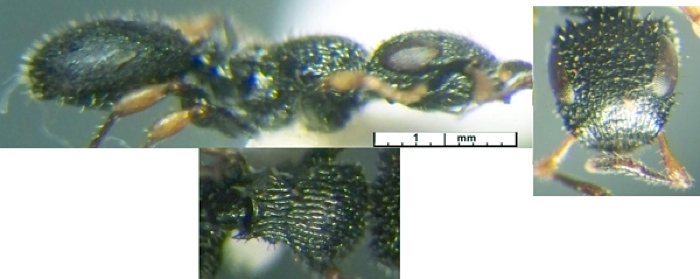 |
Nigeria & Cameroun - taylori |
| -- | 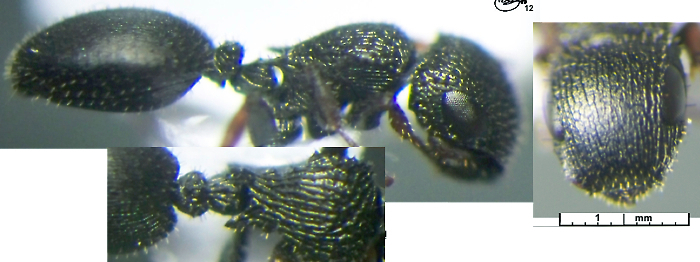 Dully shining and not obviously
highly polished; longitudinal rugae tending to diverge and converge
along their lengths or to be weakly wavy; with links on the propodeum;
TL 3.3-4.5 mm Dully shining and not obviously
highly polished; longitudinal rugae tending to diverge and converge
along their lengths or to be weakly wavy; with links on the propodeum;
TL 3.3-4.5 mm |
Benin - difficilis |
| Either the subpetiolar complex simple, a rectangular or subrectangular lobe unlike above, or with a feebly prominent acute angle or small tooth posteroventrally, if the latter the postpetiole with a short blunt or short tooth-like ventral process | -- | |
| 35 | 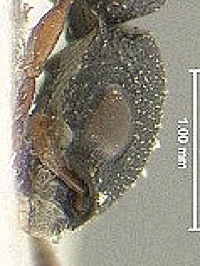 Dorsum of head with
very
short erect hairs; also usually with a sharp transition from the face
to the occiput Dorsum of head with
very
short erect hairs; also usually with a sharp transition from the face
to the occiput |
36 |
| -- | 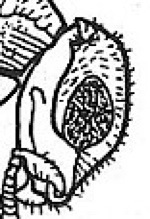 Dorsum
of head with conspicuous and quite dense
hairs; smooth transition from face to occiput Dorsum
of head with conspicuous and quite dense
hairs; smooth transition from face to occiput |
37 |
| 36 | 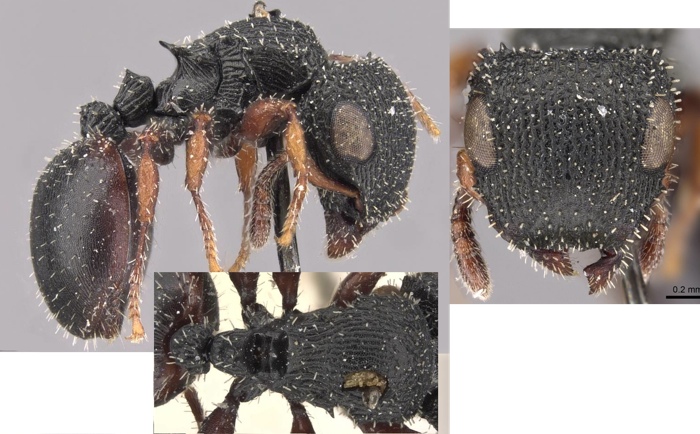 Mesokatepisternum
tooth long and acute, usually clearly visible in dorsal view; TL
3.3-3.7 mm Mesokatepisternum
tooth long and acute, usually clearly visible in dorsal view; TL
3.3-3.7 mm |
South Africa - micans |
| -- | 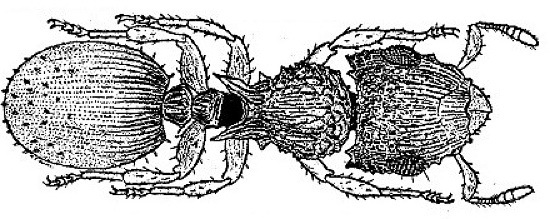 Mesokatepisternum
tooth
small and short, usually no more than a tubercle and not visible in
dorsal view; TL 4.3-5.1 mm Mesokatepisternum
tooth
small and short, usually no more than a tubercle and not visible in
dorsal view; TL 4.3-5.1 mm |
. |
| .. | 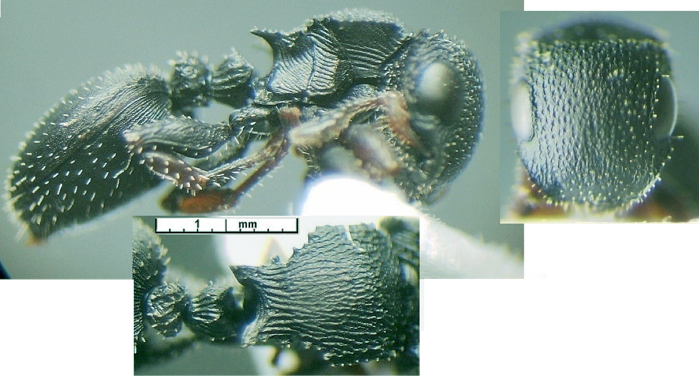 |
eastern & southern Africa - intrudens (part, rugosus group) |
 |
Dorsum of head with conspicuous and quite dense hairs; smooth transition from face to occiput | . |
| 37 | 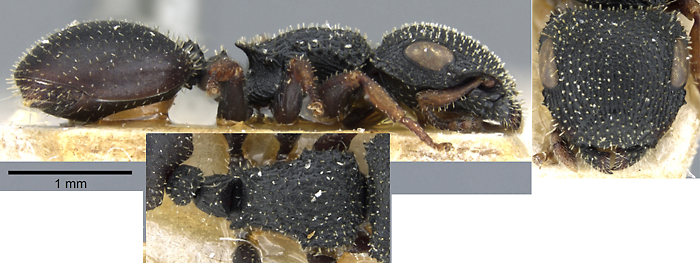 Larger
species, HW > 1.10, PW > 0.90; dorsal surfaces finely but
very strongly and closely reticulate-punctate; TL 4.5-5.1 mm Larger
species, HW > 1.10, PW > 0.90; dorsal surfaces finely but
very strongly and closely reticulate-punctate; TL 4.5-5.1 mm |
Zaïre - bequaerti |
| -- | Smaller species, HW < 1.10, PW < 0.90 | 38 |
| 38 | 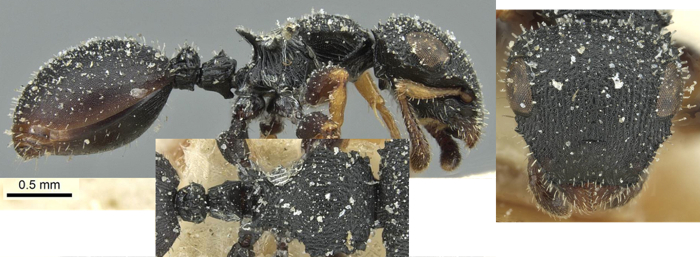 Lateral
pronotum with irregular tuberculiform projections; TL 3.5-3.8 mm Lateral
pronotum with irregular tuberculiform projections; TL 3.5-3.8 mm |
South Africa - fricatidorsus |
| -- | Lateral pronotum with series of denticles | 39 |
| 39 | 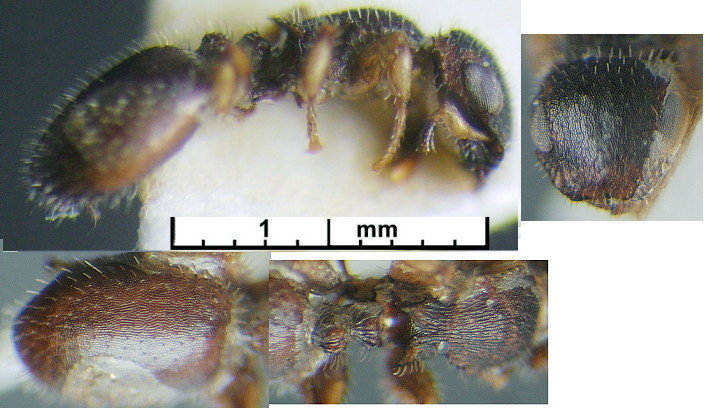 Dorsal
surfaces of mesonotum and propodeum
extremely finely and very densely but more or less evenly
longitudinally rugulose, rugulae so close together that spaces between
have only 1-2 rows of punctures; TL 3.6-4.0 mm (note specimen shown
smaller than type) Dorsal
surfaces of mesonotum and propodeum
extremely finely and very densely but more or less evenly
longitudinally rugulose, rugulae so close together that spaces between
have only 1-2 rows of punctures; TL 3.6-4.0 mm (note specimen shown
smaller than type) |
Cameroun - mckeyi |
| -- | 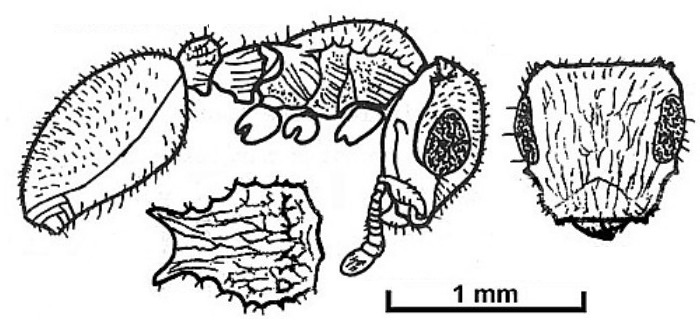 Dorsal
surfaces of mesonotum and propodeum
coarsely rugose, rugae predominantly longitudinal but with some strong
cross-meshes, breaks or irregularities; rugae widely spaced; TL 3.7-4.4
mm Dorsal
surfaces of mesonotum and propodeum
coarsely rugose, rugae predominantly longitudinal but with some strong
cross-meshes, breaks or irregularities; rugae widely spaced; TL 3.7-4.4
mm |
. |
| .. |  |
Pan-African forests - traegaordhi |
| .. |
Cataulacus species MThis was collected by Room (1971) from one of his canopy samples at cocoa farms in Ghana, but seems to have escaped the attention of Bolton (1974a), so I cannot allocate a definite name. |
.. |
| MYRMICINAE Introduction |
© 2007, 2008, 2009, 2010, 2011, 2013. 2014, 2015 -
Brian
Taylor CBiol FSB FRES 11, Grazingfield, Wilford, Nottingham, NG11 7FN, U.K. |
href="cataulacus.htm"